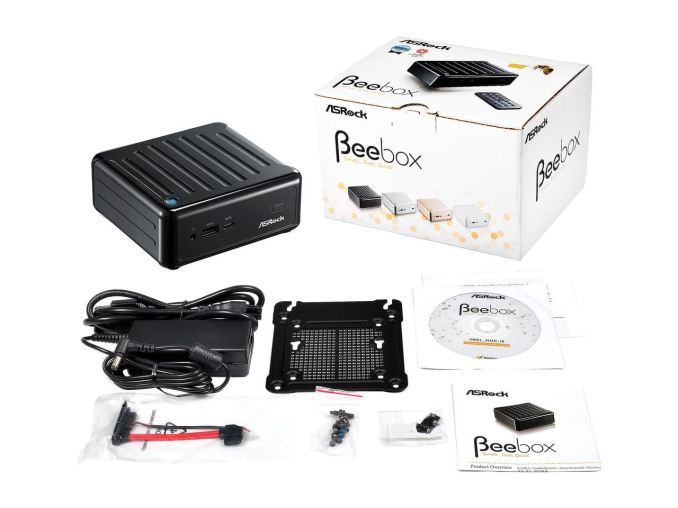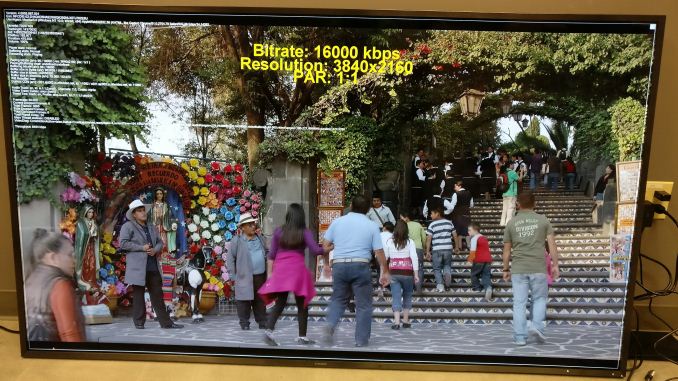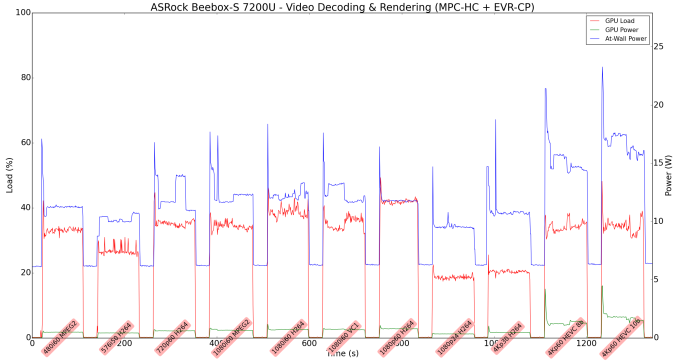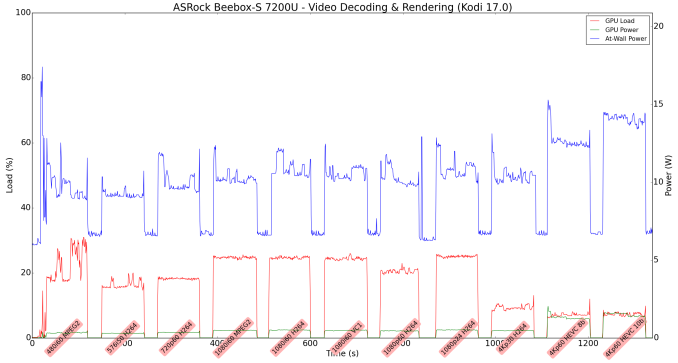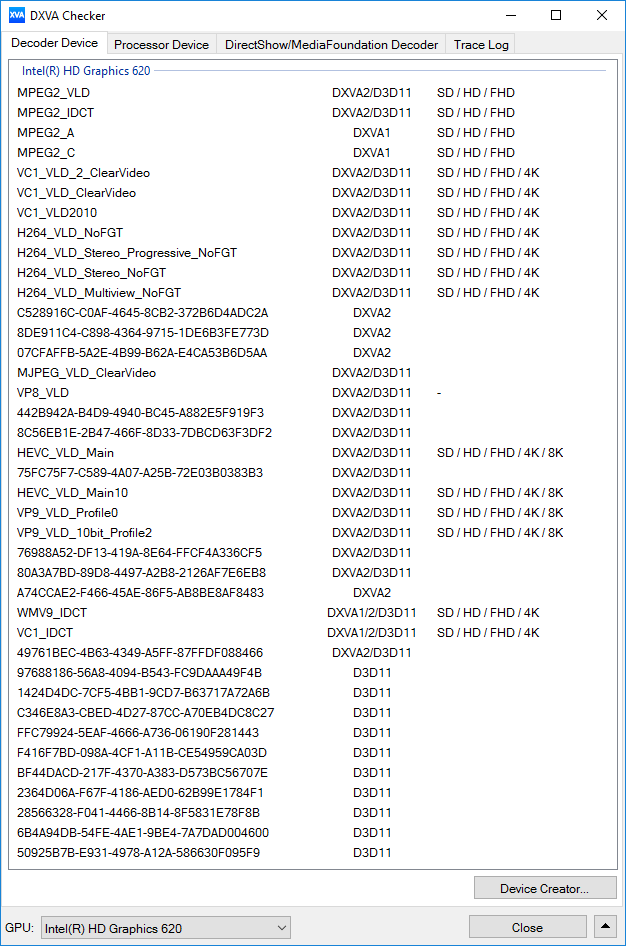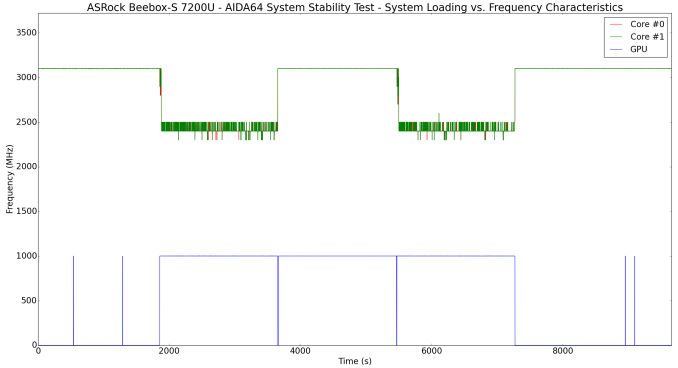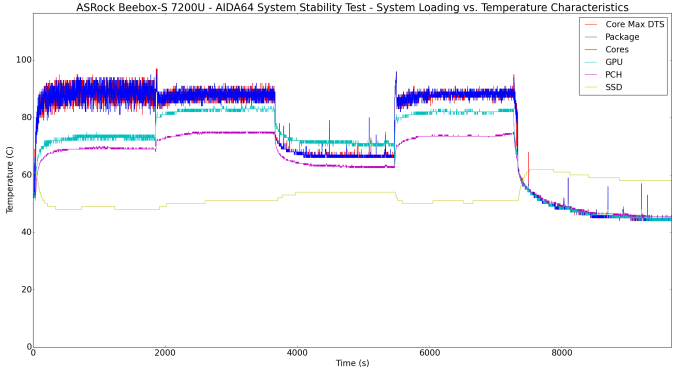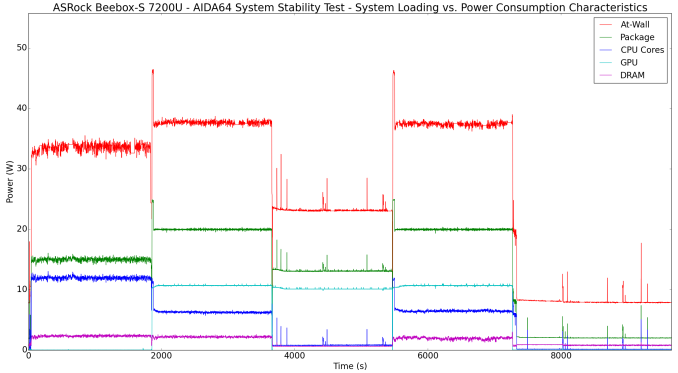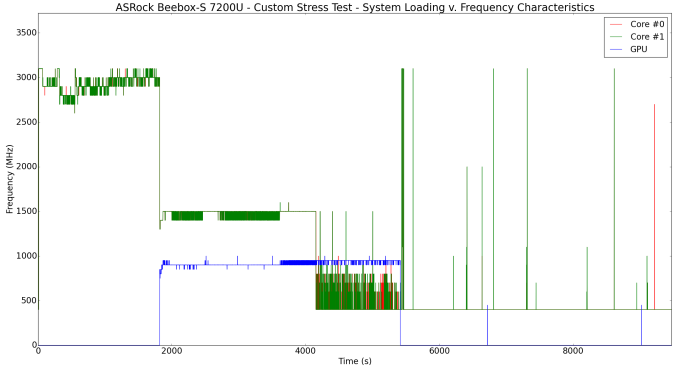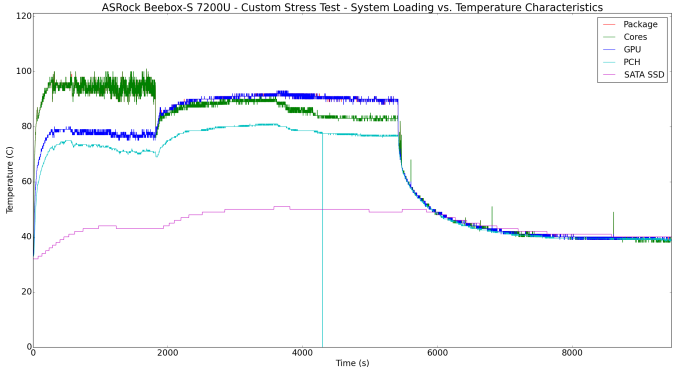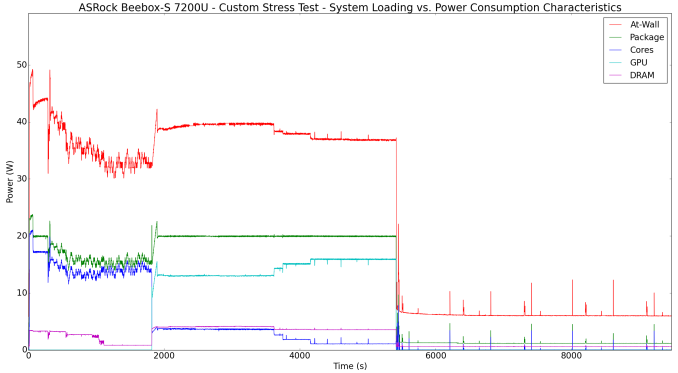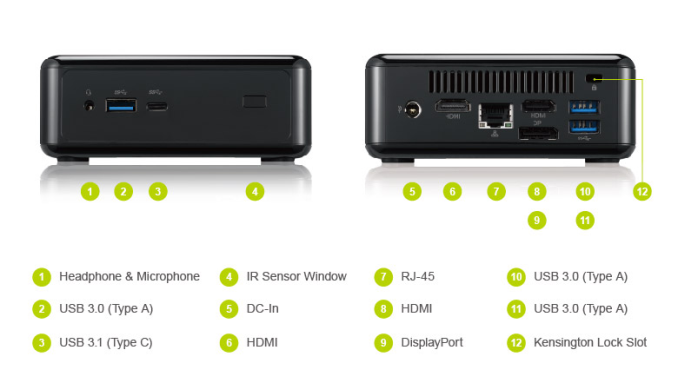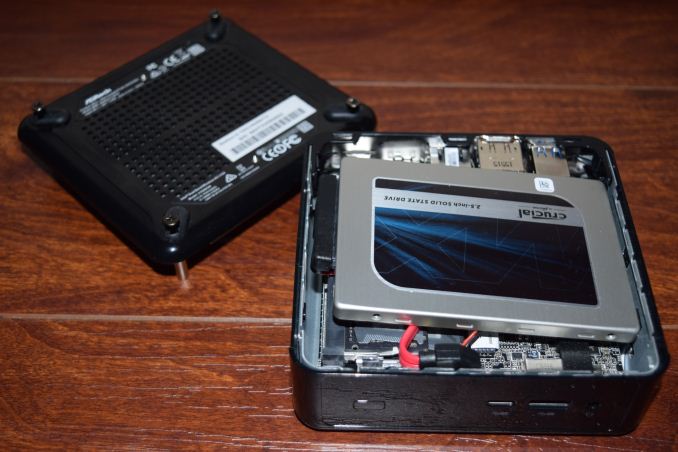
Original Link: https://www.anandtech.com/show/11095/asrock-beeboxs-7200u-kaby-lake-ucff-pc-review
ASRock Beebox-S 7200U Kaby Lake UCFF PC Review
by Ganesh T S on February 7, 2017 8:00 AM EST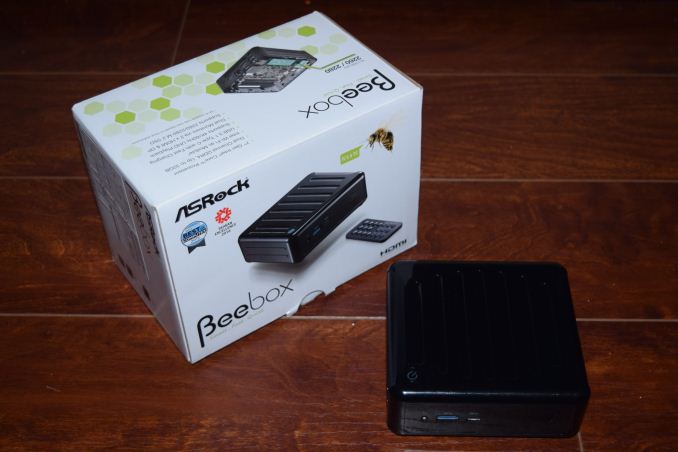
The Kaby Lake-U (KBL-U) series with 15W TDP CPUs was introduced along with the 4.5W Kaby Lake-Y ones in Q3 2016. The first set of products with Kaby Lake-U were ultrabooks. However, ultra-compact form-factor (UCFF) PCs were not long behind. There are already three vendors in the market with Kaby Lake UCFF PCs - ASRock (Beebox-S), GIGABYTE (BRIX), and MSI (Cubi 2). We have already reviewed the MSI Cubi 2 - a no-frills Kaby Lake 'NUC' The most important differentiating features of the ASRock Beebox-S 7200U include a USB 3.1 Gen 2 bridge, as well as a LSPCon (for HDMI 2.0 / HDCP 2.2 support) on the motherboard. This review takes a look at how the ASRock Beebox-S 7200U fares in typical UCFF PC workloads.
Introduction
Ultra-compact form factor (UCFF) PCs have become quite popular after Intel introduced the NUCs. They have become powerful enough to be the primary computing platform for many households. In addition to the Intel NUCs, many system vendors have come up with their own approach to UCFF PCs. These include ASRock (with the Beebox series), ECS (LIVA), GIGABYTE (BRIX), and MSI (Cubi) amongst others.
Kaby Lake-U, as per Intel's claims, is fabricated on a much more mature 14nm process and brings about a 11% improvement in performance for the same power consumption. The GPU's media engine has also been updated. On the whole, the performance improvements look good for UCFF PCs - particularly for those upgrading from the first or second-generation systems.
We have reviewed multiple Beebox systems before (Cherry Trail, Skylake), and, from an industrial design viewpoint, the Beebox-S 7200U Kaby Lake version is no different. The dimensions are one of the smallest to allow the installation of a 2.5" drive. Unlike the MSI Cubi 2, the Beebox-S 7200U supports a M.2 2280 SSD (with the help of a M.2 riser - the same as the one used in the Skylake Beebox-S 6200U).
The Kaby Lake Beebox series is currently made of two SKUs, one based on the Core i3-7100U and another based on the Core i5-7200U. Both of these come barebones (no storage, memory, or OS). ASRock sampled us the version with the Core i5-7200U. The Beebox-S 7200U can take up to two DDR4 SO-DIMMs (operating at 2133 MHz). We completed the hardware build to result in the following specifications for our Beebox-S 7200U review configuration. Note that we processed most of our benchmarks with the NVMe drive, but a few testing routines used the SATA SSD (the relevant sections will go into the details).
| ASRock Beebox-S 7200U Specifications | |
| Processor | Intel Core i5-7200U Kaby Lake, 2C/4T, 2.5 GHz (up to 3.1 GHz), 14nm PLUS, 3MB L2, 15W TDP |
| Memory | G Skill F4-2133C15-8GRS DDR4 15-15-15-36 @ 2133 MHz 2x8 GB |
| Graphics | Intel HD Graphics 620 |
| Disk Drive(s) | Samsung SSD 950 PRO (512 GB; M.2 Type 2280 PCIe 3.0 x4 NVMe; 40nm; MLC V-NAND) (OR) Crucial MX200 CT500MX200SSD1 (500 GB; 2.5in SATA 6Gb/s; 16nm; MLC) |
| Networking | Intel Dual Band Wireless-AC 3160 (1x1 802.11ac - 433 Mbps) 1x Intel I-219V Gigabit LAN |
| Display | 1x mini-Display Port 1.2 (3840x2160 @ 60 Hz) 1x HDMI 1.4b (4096x2160 @ 24 Hz) 1x HDMI 2.0a (3840x2160 @ 60 Hz) |
| Audio | 3.5mm Headphone Jack & Microphone Combo Jack Capable of 5.1/7.1 digital output with HD audio bitstreaming (HDMI) |
| Miscellaneous I/O Ports | 3x USB 3.0 (Type-A) 1x USB 3.1 Gen 2 (Type-C) |
| Operating System | Retail unit is barebones, but we installed Windows 10 Pro x64 |
| Pricing | $350 (barebones) $815 (as configured with NVMe SSD) / $666 (as configured with SATA SSD) |
| Full Specifications | ASRock Beebox-S 7200U specifications |
The ASRock Beebox-S 7200U kit doesn't come with any pre-installed OS, but does come with a CD containing Windows drivers. In any case, we ended up installing the latest drivers downloaded off ASRock's product support page. In addition to the main unit, the other components of the package include a 65 W (19V @ 3.42A) adapter with a US power connector, a VESA mount (along with the necessary screws), a driver CD, user's manual and a quick-start guide. In addition, we also have the appropriate cables - both data and power - to install a 2.5" drive in the system. A small IR remote control with a pre-installed CR232 battery (not shown in the picture below) is also part of the package.
The unique part of the package is a small plastic tab and an additional screw that allows for installation of a M.2 2280 SSD in the unit. Note that even though Kaby Lake-U can theoretically support up to three simultaneous displays, the Beebox-S 7200U supports only two at a time (either HDMI 2.0 + HDMI 1.4 or HDMI 2.0 + DP). Other components that reside on the underside of the motherboard include the ASMedia ASM1142 USB 3.1 bridge chip and the MegaChips LSPCon to enable the HDMI 2.0 output from the DisplayPort output of the Kaby Lake-U SiP. The most important update from the Skylake Beebox is the additional HDCP 2.2 capability and DRM capabilities enabled by the Kaby Lake-U processor.
The PCIe lanes from the SiP are distributed as follow:
- PCI-E 2.0 x1 port #4 In Use @ x1 (ASMedia ASM1142 USB 3.1 xHCI Controller)
- PCI-E 2.0 x1 port #5 In Use @ x1 (Intel Dual Band Wireless-AC 3160 AC HMC WiFi Adapter)
- PCI-E 2.0 x4 port #9 In Use @ x4 (Samsung NVMe SSD Controller)
ASRock's BIOS has plenty of features that are missing in the BIOS from other vendors. I will not go into the details of all the BIOS features, but, readers interested in checking out the available options can peruse the user manual available here.
Compared to the MSI Cubi 2 with Kaby Lake, we find the Realtek GbE adapter replaced by the Intel I-219V. The Wi-Fi adapter is the Intel AC3160 compared to the AC3168. Compared to the barebones Core i5 version of the Cubi 2 (Cubi2-006BUS) at $375, the Beebox-S 7200U with the same processor is cheaper at $350 and also comes with better capabilities.
In the table below, we have an overview of the various systems that we are comparing the ASRock Beebox-S 7200U against. Note that they may not belong to the same market segment. The relevant configuration details of the machines are provided so that readers have an understanding of why some benchmark numbers are skewed for or against the ASRock Beebox-S 7200U when we come to those sections.
| Comparative PC Configurations | ||
| Aspect | ASRock Beebox-S 7200U | |
| CPU | Intel Core i5-7200U | Intel Core i5-7200U |
| GPU | Intel HD Graphics 620 | Intel HD Graphics 620 |
| RAM | G Skill F4-2133C15-8GRS DDR4 15-15-15-36 @ 2133 MHz 2x8 GB |
G Skill F4-2133C15-8GRS DDR4 15-15-15-36 @ 2133 MHz 2x8 GB |
| Storage | Samsung SSD 950 PRO (512 GB; M.2 Type 2280 PCIe 3.0 x4 NVMe; 40nm; MLC V-NAND) |
Samsung SSD 950 PRO (512 GB; M.2 Type 2280 PCIe 3.0 x4 NVMe; 40nm; MLC V-NAND) |
| Wi-Fi | Intel Dual Band Wireless-AC 3160 (1x1 802.11ac - 433 Mbps) |
Intel Dual Band Wireless-AC 3160 (1x1 802.11ac - 433 Mbps) |
| Price (in USD, when built) | $350 (barebones) $815 (as configured) |
$350 (barebones) $815 (as configured) |
Performance Metrics - I
The ASRock Beebox-S 7200U was evaluated using our standard test suite for low power desktops / industrial PCs. Not all benchmarks were processed on all the machines due to updates in our testing procedures. Therefore, the list of PCs in each graph might not be the same. In the first section, we will be looking at SYSmark 2014 SE, as well as some of the Futuremark benchmarks.
BAPCo SYSmark 2014 SE
BAPCo's SYSmark 2014 SE is an application-based benchmark that uses real-world applications to replay usage patterns of business users in the areas of office productivity, media creation and data/financial analysis. In addition, it also addresses the responsiveness aspect which deals with user experience as related to application and file launches, multi-tasking etc. Scores are meant to be compared against a reference desktop (the SYSmark 2014 SE calibration system in the graphs below). While the SYSmark 2014 benchmark used a Haswell-based desktop configuration, the SYSmark 2014 SE makes the move to a Lenovo ThinkCenter M800 (Intel Core i3-6100, 4GB RAM and a 256GB SATA SSD). The calibration system scores 1000 in each of the scenarios. A score of, say, 2000, would imply that the system under test is twice as fast as the reference system.
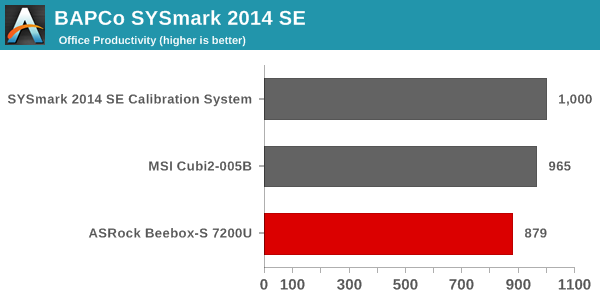
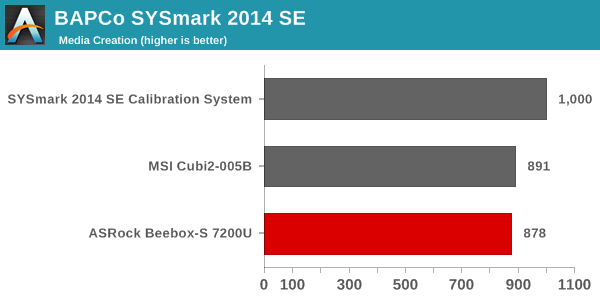
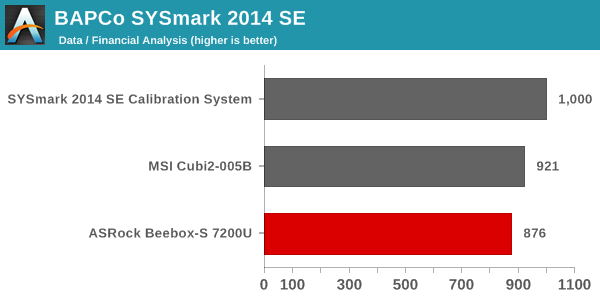
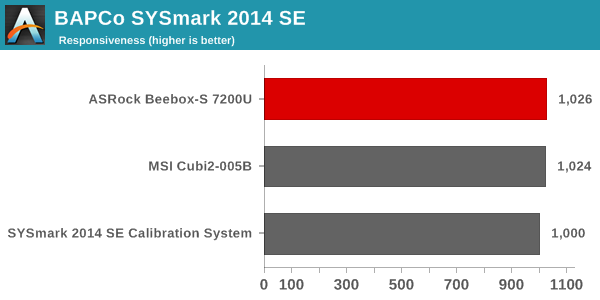
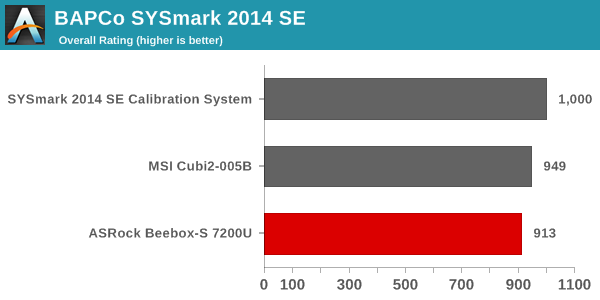
The scores tend to align with the capabilities of the CPU in the systems. The Core i5-7200U in the Beebox-S slightly lags the Core i7-7500U in the Cubi 2 in terms of both cache size and clock frequency. Obviously, neither of them can match the capabilities of the desktop-class CPU with higher TDP in the calibration system. The only scenario where the Beebox-S scores is responsiveness - likely due to the use of a NVMe SSD compared to the SATA SSD used in the Cubi 2.
SYSmark 2014 SE also adds energy measurement to the mix. A high score in the SYSmark benchmarks might be nice to have, but, potential customers also need to determine the balance between power consumption and the efficiency of the system. For example, in the average office scenario, it might not be worth purchasing a noisy and power-hungry PC just because it ends up with a 2000 score in the SYSmark 2014 SE benchmarks. In order to provide a balanced perspective, SYSmark 2014 SE also allows vendors and decision makers to track the energy consumption during each workload. In the graphs below, we find the total energy consumed by the PC under test for a single iteration of each SYSmark 2014 SE workload and how it compares against the calibration systems.
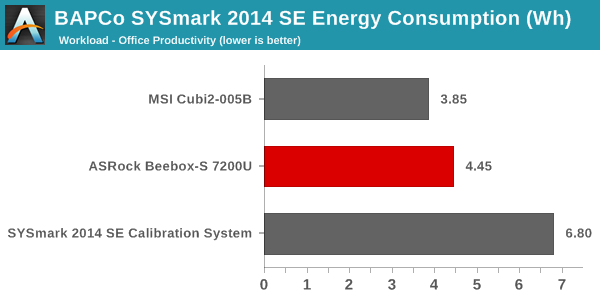
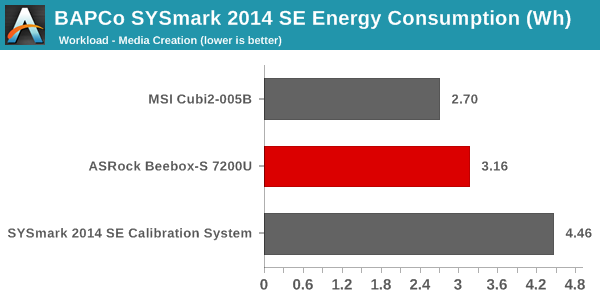
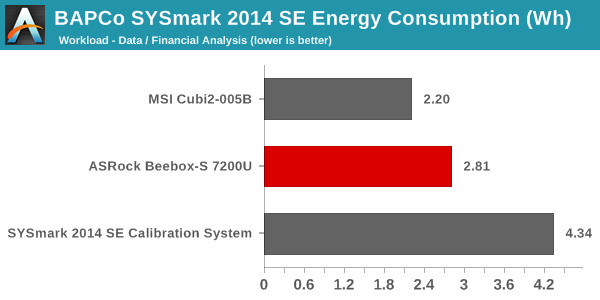
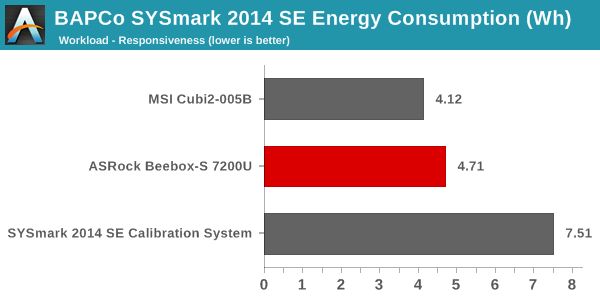
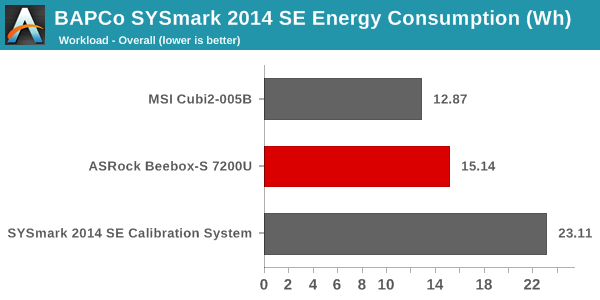
The comparative energy consumption numbers for each scenario are as expected. The Beebox-S is slightly more energy-intensive (despite the use of a CPU with the same TDP as the Cubi 2) likely due to the more power-hungry NVMe SSD in the assembled configuration.
Futuremark PCMark 8
PCMark 8 provides various usage scenarios (home, creative and work) and offers ways to benchmark both baseline (CPU-only) as well as OpenCL accelerated (CPU + GPU) performance. We benchmarked select PCs for the OpenCL accelerated performance in all three usage scenarios. These scores are heavily influenced by the CPU in the system. The storage system also plays a significant role - which is why we see the Beebox-S 7200U and the MSI Cubi 2 trade positions in the top two spots depending on the benchmark. Interestingly, for these workloads, the 15W TDP Core i5-7200U is enough to go past the Skylake and Broadwell BRIX units that configure the CPU for a 28W TDP.
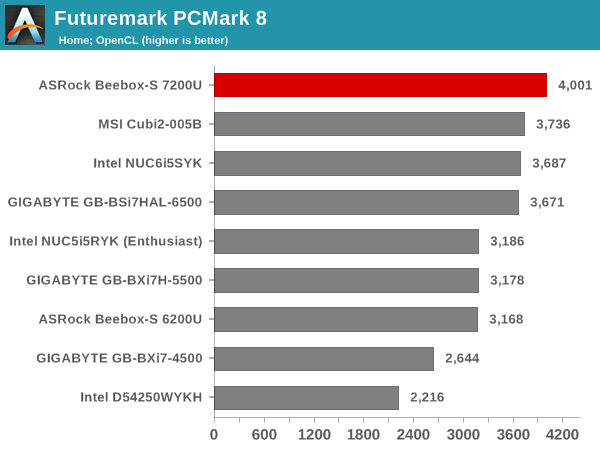
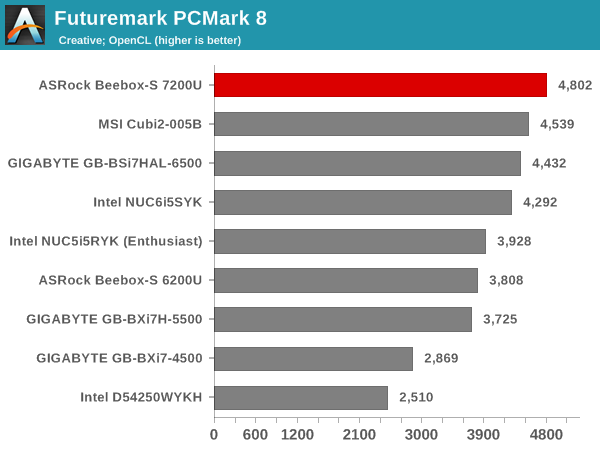
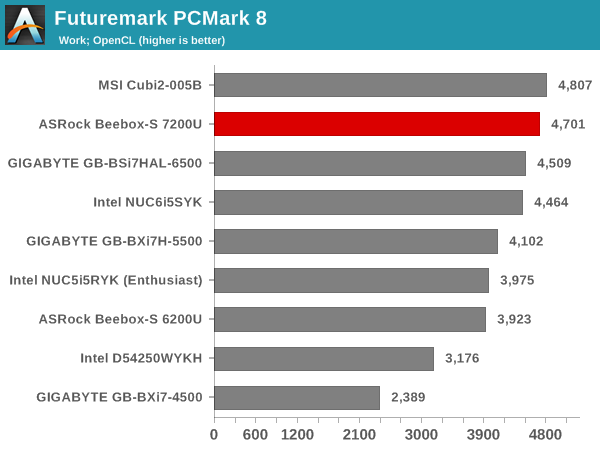
Miscellaneous Futuremark Benchmarks
The GPU-focused benchmarks perform similarly for both the Beebox-S 7200U and the Cubi 2. However, the Skylake Intel NUC with Iris Graphics manages to comfortably outscore the Intel HD Graphics 620 in the Beebox-S 7200U.
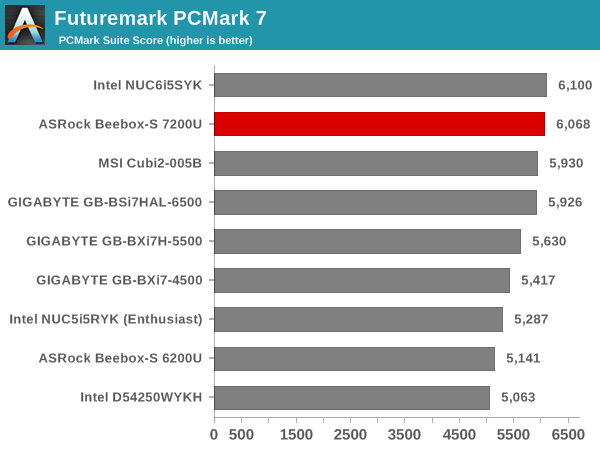
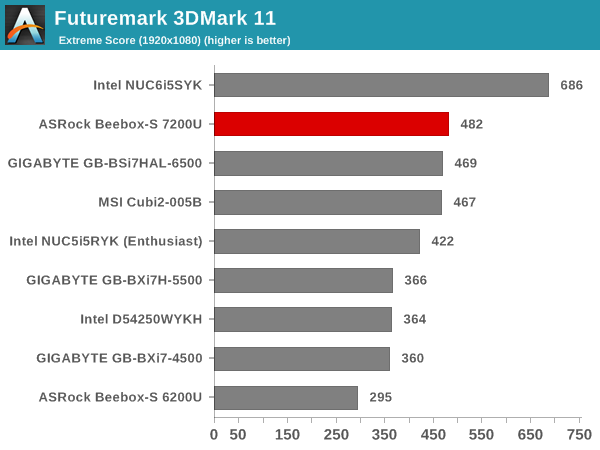
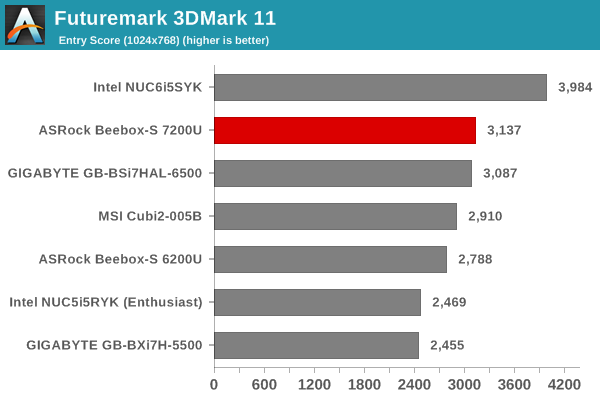
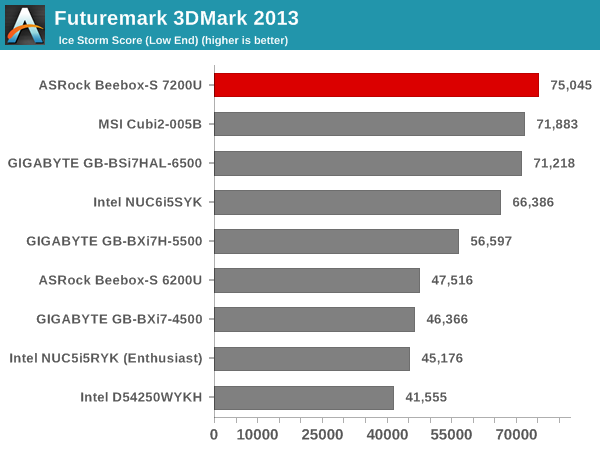
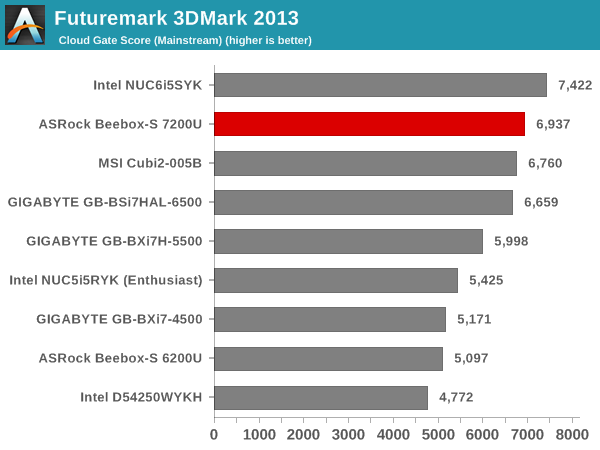
3D Rendering - CINEBENCH R15
We have moved on from R11.5 to R15 for 3D rendering evaluation. CINEBENCH R15 provides three benchmark modes - OpenGL, single threaded and multi-threaded. Evaluation of select PCs in all three modes provided us the following results. The OpenGL version numbers stack up similar to the Futuremark GPU benchmarks. The CPU versions are in line with expectations for a Core i5 U-series CPU.
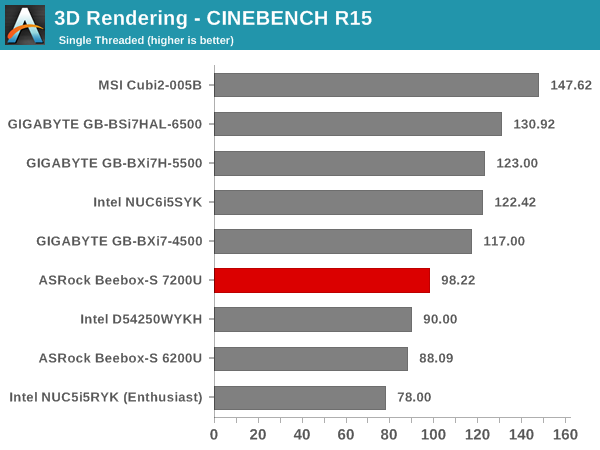
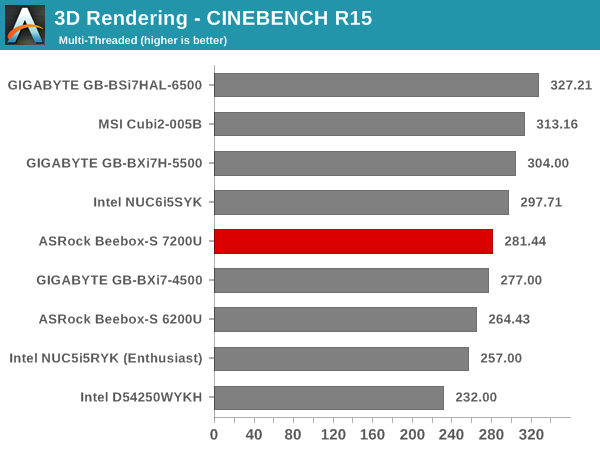
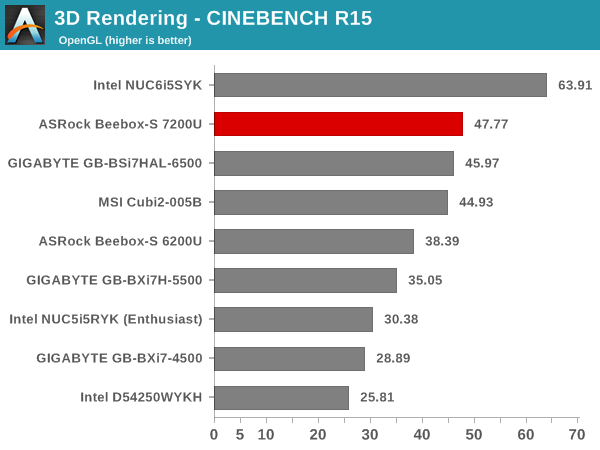
Performance Metrics - II
In this section, we mainly look at benchmark modes in programs used on a day-to-day basis, i.e, application performance and not synthetic workloads.
x264 Benchmark
First off, we have some video encoding benchmarks courtesy of x264 HD Benchmark v5.0. This is simply a test of CPU performance. As expected, the Core i5-based Beebox-S 7200U can't match the performance of the Core i7-based UCFF PCs such as the Cubi 2 or the Skylake BRIX.
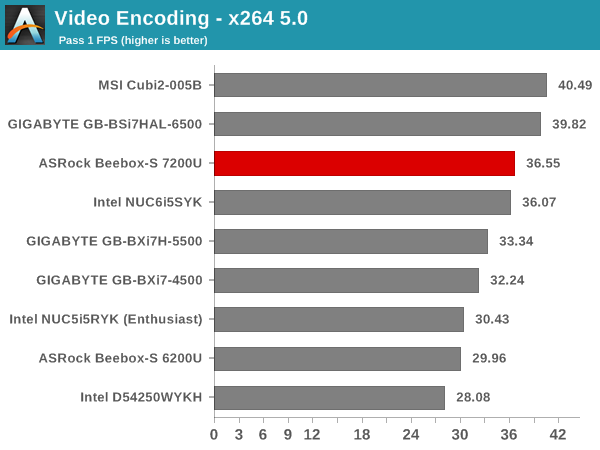
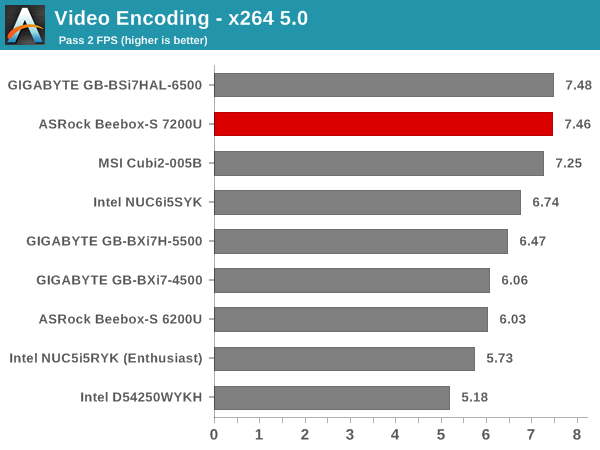
7-Zip
7-Zip is a very effective and efficient compression program, often beating out OpenCL accelerated commercial programs in benchmarks even while using just the CPU power. 7-Zip has a benchmarking program that provides tons of details regarding the underlying CPU's efficiency. In this subsection, we are interested in the compression and decompression MIPS ratings when utilizing all the available threads.
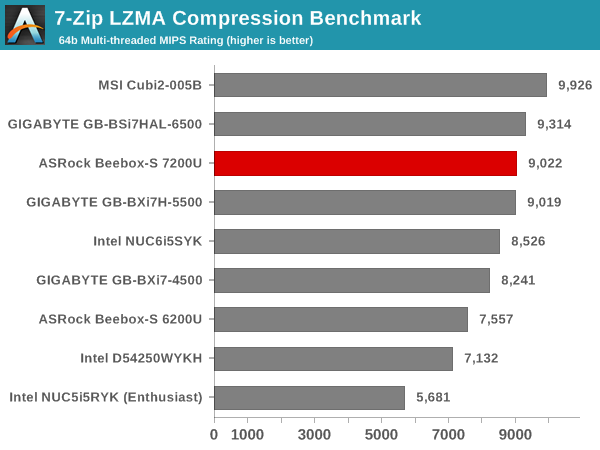
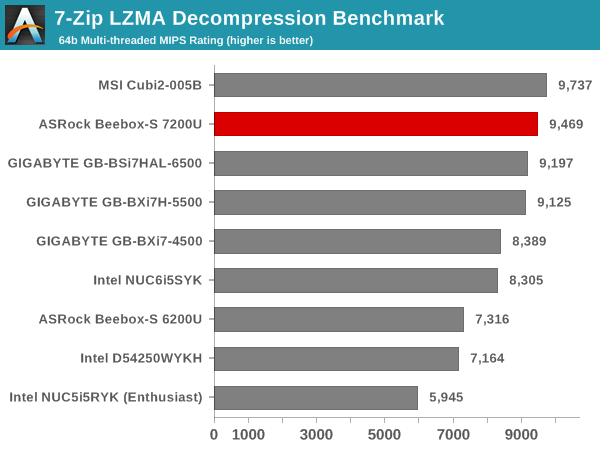
TrueCrypt
As businesses (and even home consumers) become more security conscious, the importance of encryption can't be overstated. CPUs supporting the AES-NI instruction have hardware acceleration for the encryption and decryption processes. The Core i5-7200U in the Beebox-S 7200U does have AES-NI support. TrueCrypt, a popular open-source disk encryption program can take advantage of the AES-NI capabilities. The TrueCrypt internal benchmark provides some interesting cryptography-related numbers to ponder. In the graph below, we can get an idea of how fast a TrueCrypt volume would behave in the ASRock Beebox-S 7200U and how it would compare with other select PCs. This is a purely CPU feature / clock speed based test.
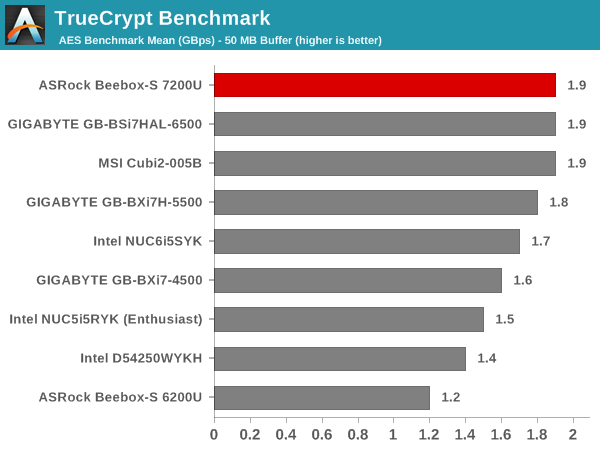
Agisoft Photoscan
Agisoft PhotoScan is a commercial program that converts 2D images into 3D point maps, meshes and textures. The program designers sent us a command line version in order to evaluate the efficiency of various systems that go under our review scanner. The command line version has two benchmark modes, one using the CPU and the other using both the CPU and GPU (via OpenCL). The benchmark takes around 50 photographs and does four stages of computation:
- Stage 1: Align Photographs
- Stage 2: Build Point Cloud (capable of OpenCL acceleration)
- Stage 3: Build Mesh
- Stage 4: Build Textures
We record the time taken for each stage. Since various elements of the software are single threaded, others multithreaded, and some use GPUs, it is interesting to record the effects of CPU generations, speeds, number of cores, DRAM parameters and the GPU using this software.
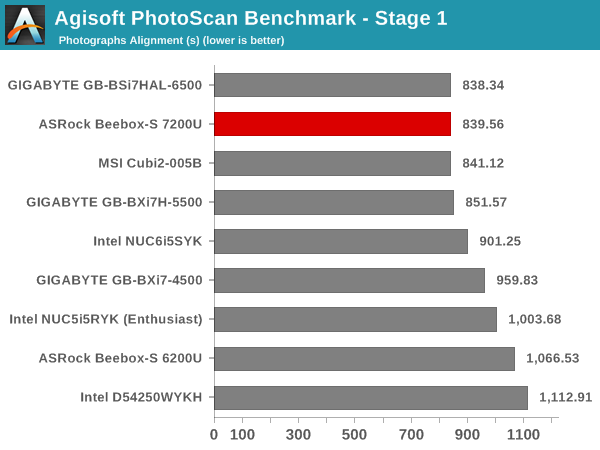
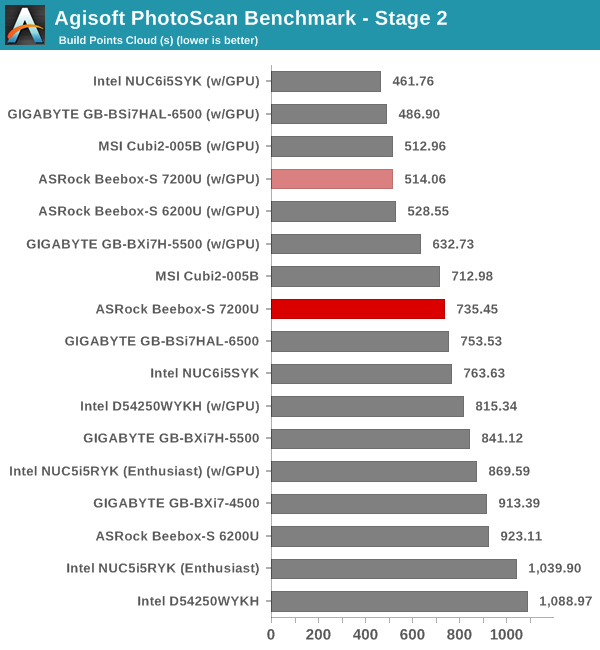
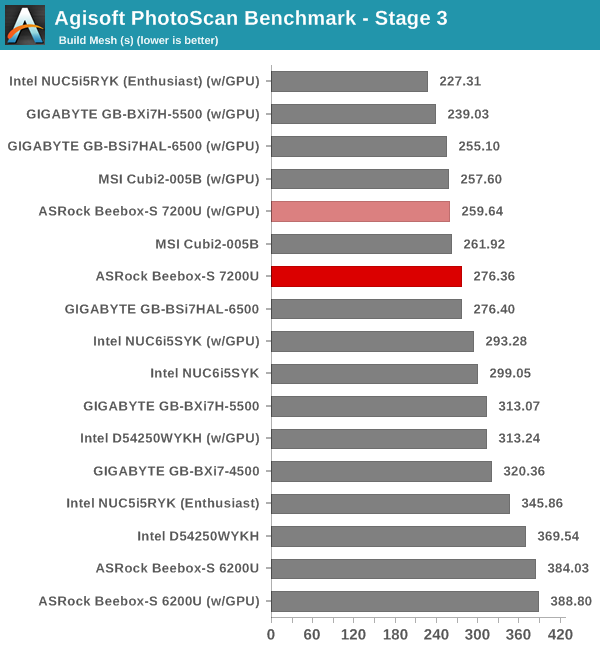
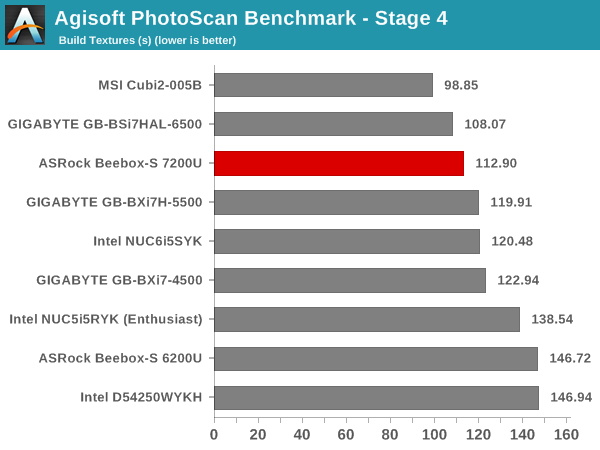
Dolphin Emulator
Wrapping up our application benchmark numbers is the Dolphin Emulator benchmark mode results. This is again a test of the CPU capabilities, with the Beebox-S 7200U only outclassed by the Skylake BRIX in our list of UCFF PCs.
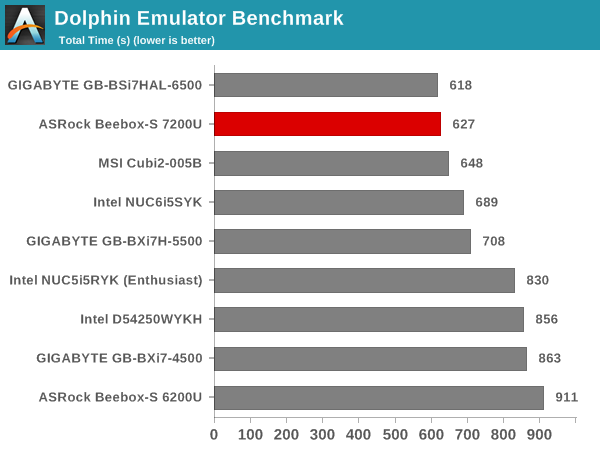
Networking and Storage Performance
Networking and storage are two major aspects which influence our experience with any computing system. This section presents results from our evaluation of these aspects in the ASRock Beebox-S 7200U. On the storage side, one option would be repetition of our strenuous SSD review tests on the drive(s) in the PC. Fortunately, to avoid that overkill, PCMark 8 has a storage bench where certain common workloads such as loading games and document processing are replayed on the target drive. Results are presented in two forms, one being a benchmark number and the other, a bandwidth figure. We ran the PCMark 8 storage bench on selected PCs and the results are presented below.
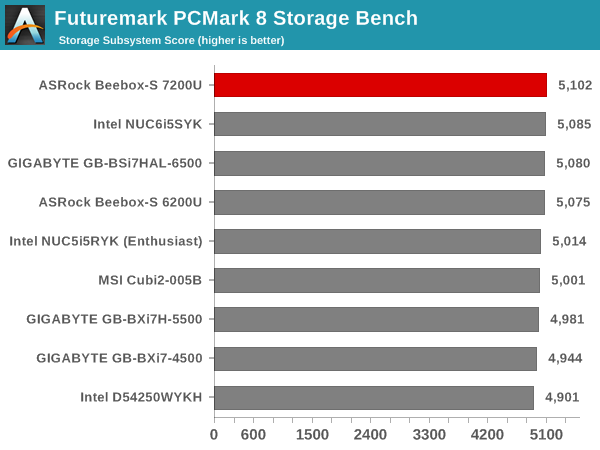
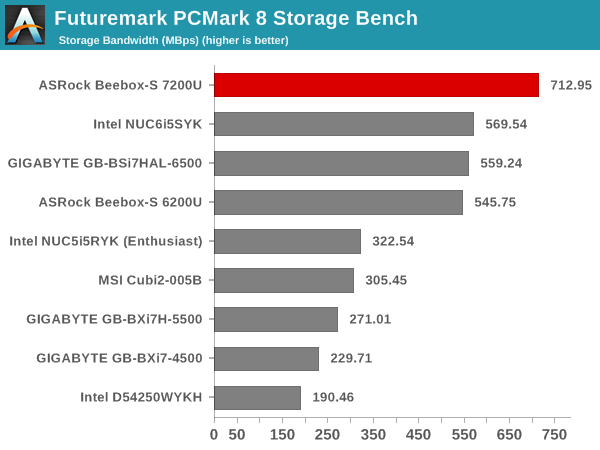
The Samsung SSD 950 PRO PCIe 3.0 x4 NVMe SSD is able to deliver on its full potential when used in the Beebox-S 7200U. The uplink to the SiP is true PCIe 3.0 x4, unlike some of the Skylake-U UCFF PCs.
On the networking side, we restricted ourselves to the evaluation of the WLAN component. Our standard test router is the Netgear R7000 Nighthawk configured with both 2.4 GHz and 5 GHz networks. The router is placed approximately 20 ft. away, separated by a drywall (as in a typical US building). A wired client with an Intel GbE LAN port is connected to the R7000 and serves as one endpoint for iperf evaluation. The PC under test is made to connect to either the 5 GHz (preferred) or 2.4 GHz SSID and iperf tests are conducted for both TCP and UDP transfers. It is ensured that the PC under test is the only wireless client for the Netgear R7000. We evaluate total throughput for up to 32 simultaneous TCP connections using iperf and present the highest number in the graph below.
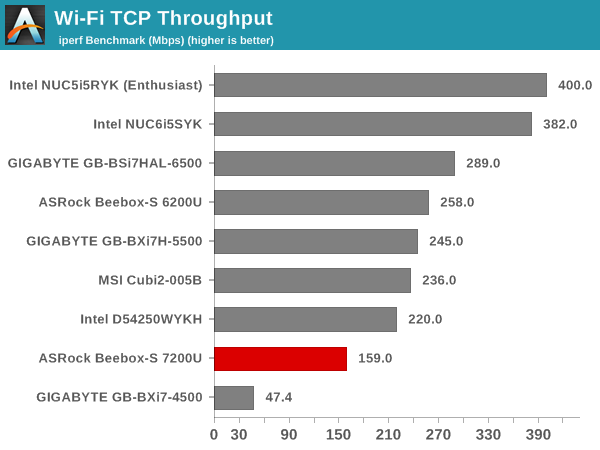
In the UDP case, we try to transfer data at the highest rate possible for which we get less than 1% packet loss.
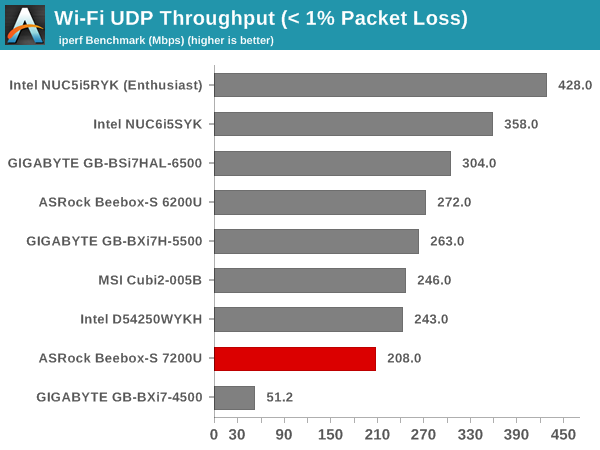
Despite sporting the same WLAN adapter as the Beebox-S 6200U, we find that the Wi-Fi performance of the Kaby Lake unit is much worse compared to the Skylake version. Some customer reviews have indicated that swapping the pigtail connections in the WLAN card helps in improving the performance, though we found that out after our benchmarking was completed.
HTPC Credentials
The Beebox-S series, unlike the Braswell Beebox, does not have any fanless members. However, the noise profile is attractive enough for the unit to be used as a HTPC. Operation of the Core i5-7200U at its default TDP ensures that the fan doesn't need to spin as fast as what we have seen in some of the other UCFF PCs (which configure the TDP up). However, given the specifications of the Intel HD Graphics 620, it is clear that the Beebox-S 6200U is more suited for the casual HTPC user, rather than someone who wants all the bells and whistles like customized renderers (madVR etc.). Based on this use-case, we evaluated refresh rate accuracy, over-the-top (OTT) streaming, and Kodi 17.0 for local media playback.
Refresh Rate Accuracy
Starting with Haswell, Intel, AMD and NVIDIA have been on par with respect to display refresh rate accuracy. The most important refresh rate for videophiles is obviously 23.976 Hz (the 23 Hz setting). As expected, the ASRock Beebox-S 7200U has no trouble with refreshing the display appropriately in this setting.
The gallery below presents some of the other refresh rates that we tested out. The first statistic in madVR's OSD indicates the display refresh rate.
Network Streaming Efficiency
Evaluation of OTT playback efficiency was done by playing back our standard YouTube test stream and five minutes from our standard Netflix test title. Using HTML5, the YouTube stream plays back a 720p encoding. Since YouTube now defaults to HTML5 for video playback, we have stopped evaluating Adobe Flash acceleration. Note that only NVIDIA exposes GPU and VPU loads separately. Both Intel and AMD bundle the decoder load along with the GPU load. The following two graphs show the power consumption at the wall for playback of the HTML5 stream in Mozilla Firefox (v 50.1.0).
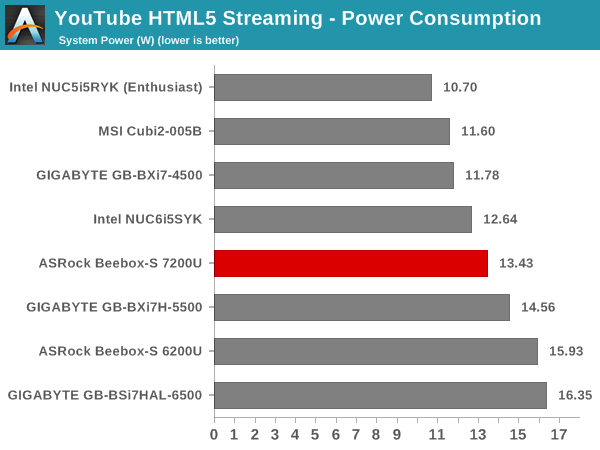
GPU load was around 9.7% for the YouTube HTML5 stream and 0.01% for the steady state 6 Mbps Netflix streaming case.
Netflix streaming evaluation was done using the Windows 10 Netflix app. Manual stream selection is available (Ctrl-Alt-Shift-S) and debug information / statistics can also be viewed (Ctrl-Alt-Shift-D). Statistics collected for the YouTube streaming experiment were also collected here.
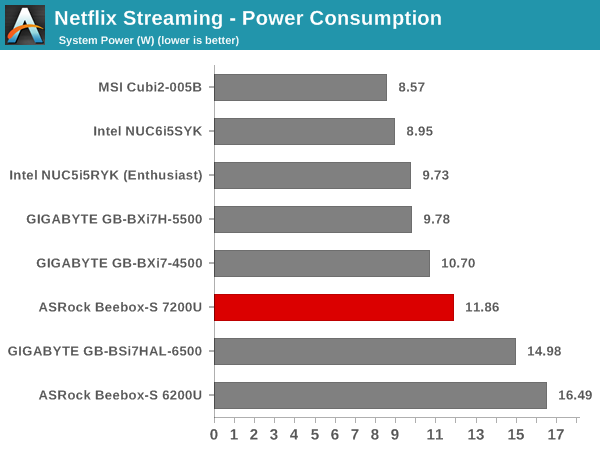
The Beebox-S 7200U is not particularly power efficient because our configuration uses a NVMe SSD. A SATA SSD cuts down the power numbers by around 2.5 to 3W in each of the scenarios.
One of the most interesting features of Kaby Lake PCs with a HDMI 2.0 / HDCP 2.2 port is the ability to play 4K Netflix streams. This is enabled by some content protection features introduced in Kaby Lake. In our initial trials, we were unable to get Netflix 4K to play back successfully despite being able to drive 4K @ 60 Hz to a HDCP 2.2-capable television. After some back and forth with ASRock, and getting hold of an updated LSPCon firmware and BIOS (v1.60), we were able to get Netflix 4K streams to work.
On the Beebox-S 7200U, our Netflix 4K test title was delivered as a 16 Mbps HEVC encode.
Decoding and Rendering Benchmarks
In order to evaluate local file playback, we concentrate on EVR-CP and Kodi 17.0. We already know that EVR works quite well even with the Intel IGP for our test streams. The decoder used was LAV Filters bundled with MPC-HC v1.7.10.276. We have now added HEVC streams to our test suite.
In our earlier reviews, we focused on presenting the GPU loading and power consumption at the wall in a table (with problematic streams in bold). Starting with the Broadwell NUC review, we decided to represent the GPU load and power consumption in a graph with dual Y-axes. Eleven different test streams of 90 seconds each were played back with a gap of 30 seconds between each of them. The characteristics of each stream are annotated at the bottom of the graph. Note that the GPU usage is graphed in red and needs to be considered against the left axis, while the at-wall power consumption is graphed in green and needs to be considered against the right axis.
Frame drops are evident whenever the GPU load consistently stays above the 85 - 90% mark. Like the MSI Cubi2-005BUS (which also uses the Intel HD Graphics 620), the ASRock Beebox-S 7200U has absolutely no trouble in keeping up with the media playback use-cases.
Moving on to the codec support, the Intel HD Graphics 620 is a known quantity with respect to the scope of supported hardware accelerated codecs (based on Intel's claims). DXVA Checker serves as a confirmation.
Kaby Lake-U has one of the most comprehensive codec supports in the market after Intel decided to add HEVC 8b and 10b full hardware decode. In fact, there is also support for 10-bit VP9 in the GPU. It is a pity that the display engine still doesn't support HDMI 2.0 natively, but ASRock has ensured that it is not a problem for the Beebox-S 7200U.
Power Consumption and Thermal Performance
The power consumption at the wall was measured with a 1080p display being driven through the HDMI port. In the graphs below, we compare the idle and load power of the ASRock Beebox-S 7200U with other low power PCs evaluated before. For load power consumption, we ran the AIDA64 System Stability Test with various stress components, as well as our custom stress test, and noted the maximum sustained power consumption at the wall.
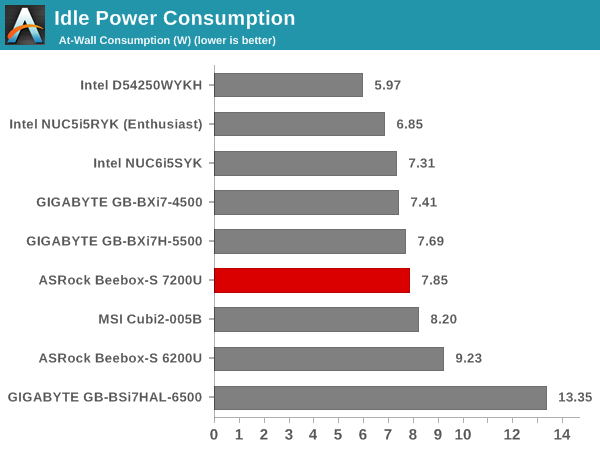
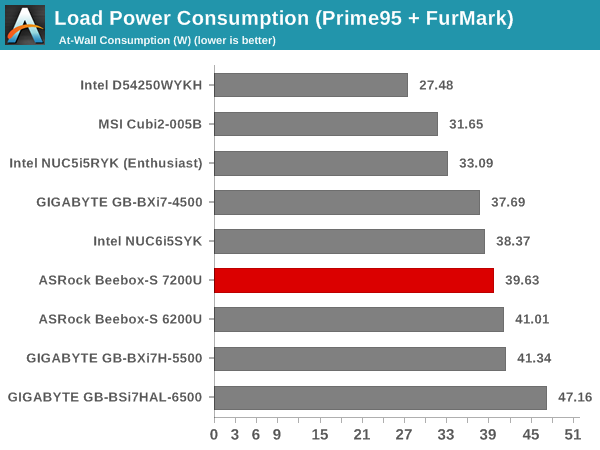
Readers, however, must not take the above numbers at face value. While the idle power is with the system configured with the Samsung SSD 950 PRO NVMe SSD, the sustained load power is for the Crucial MX200 SATA SSD configuration. The numbers not included in the above two graphs are the load power for the NVMe SSD configuration (around 37W sustained in the AIDA64 stability test) and the idle power for the SATA SSD configuration (around 6W).
The main reason for the above issue is that the Beebox-S 7200U was not stable with Prime95 when using the Samsung SSD 950 PRO NVMe SSD. The system would sometime complete hours of Prime95 without issues, but, at other times, completely freeze up the system within five minutes of starting the torture workload. After shifting to a SATA SSD, we were unable to reproduce the freezing issue. Since the torture test is one of the last to be processed on a review sample, we opted not to repeat the benchmarks done with the NVMe SSD. While the AIDA64 system stability tests were processed with the NVMe SSD configuration, our custom stress test (Prime95 and Furmark) was done with the SATA SSD configuration.
Our thermal stress routine starts with the system at idle, followed by four stages of different system loading profiles using the AIDA64 System Stability Test (each of 30 minutes duration). In the first stage, we stress the CPU, caches and RAM. In the second stage, we add the GPU to the above list. In the third stage, we stress the GPU standalone. In the final stage, we stress all the system components (including the disks). Beyond this, we leave the unit idle in order to determine how quickly the various temperatures in the system can come back to normal idling range. The various clocks, temperatures and power consumption numbers for the system during the above routine are presented in the graphs below.
According to the official specifications, the junction temperature of the Core i5-7200U is 100 C. This temperature is not reached in the AIDA64 System Stability Test. However, the sensor monitoring shows some odd aspects - the cores, for example, idle at 3.1 GHz. Pure CPU or GPU loading pegs the package power at 15W, but, distributing the stress allows the thermal solution to sustain a package power of 20W. Given that the NVMe SSD configuration failed the Prime95 stability test, let us take a look at the corresponding graphs for the SATA SSD version while processing our custom stress test.
The most interesting graph is the frequency one - with the SATA SSD, the cores idle at around 400 MHz (as they should). However, the Prime95 workload tries to peg the package power at 20W. The thermal solution, unfortunately, can't keep up with this and the temperature reaches Tjmax. This causes the clocks to scale down slightly (still remaining at or above the advertised 2.7 GHz) so as to bring down the sustained package power to around 15W. However, adding a GPU workload allows the temperatures to remain less than 90C while also sustaining a package power of 20W.
The Beebox-S 7200U is actively cooled, and the chassis is not made of metal. Therefore, the external chassis temperatures / hot spots are not much of a concern. The internal temperatures are a bit of a concern - particularly when considering the fact that the same workload on the Beebox-S 6200U Skylake version with the same NVMe SSD didn't exhibit this anomaly. It does look like the BIOS needs more work for NVMe SSD use-cases.
Final Words
The benefits delivered by Kaby Lake over Skylake are passable from a performance perspective. That said, the Kaby Lake media engine in the Intel HD Graphics 6xx has moved from lagging behind NVIDIA's VPU to becoming the leader in the space. In addition to HEVC Main as well as Main10 decode support, Intel is also delivering 10-bit VP9 decode. The benefits of the latter are debatable, but, on paper, the Kaby Lake GPU delivers the goods for HTPC users. The MSI Cubi 2 disappointed us a bit on this front by not opting to enable a HDCP 2.2-capable HDMI 2.0 output. This requires a LSPCon (approximately a $2 addition to the BOM according to our industry sources), and ASRock's Beebox-S 7200U integrates one. Kaby Lake's additional DRM capabilities also enable Netflix 4K streaming. All in all, the Beebox-S 7200U is an effective HTPC for casual 4K media consumers - either OTT, or, from local sources.
ASRock also manages to score on some other differentiation aspects - the availability of a USB 3.1 Gen 2 Type-C port, thanks to the ASMedia ASM1142 bridge controller, as well as a compact footprint while retaining support for a 2.5" drive. Unlike some of the other UCFF PCs in the market that opt for Realtek NICs, the Beebox-S 7200U does sport an Intel Gigabit LAN controller.
Positives aside, ASRock still has some scope for improving the Beebox-S. Most of our feedback from the Beebox-S 6200U review are still valid since the chassis design and motherboard components of the Beebox-S 7200U are almost the same (except for the processor and the BIOS).
The internal layout of the unit is very cramped, making even SODIMM installation a bit of a challenge. Installing a 2.5" drive is even more of a pain with the necessity to route the SATA cable and power wires around the SODIMM. While the initial setup issue is a one-time hassle, the effect of the SODIMM heating up on the SATA cable is a bit of a worry. ASRock must shift to a single flexible data/power cable (similar to the one used in the DeskMini 110) to address this issue. Another candidate for addressing is the decision to go with a 1x1 802.11ac WLAN card instead of the 2x2 configuration used by the Intel NUCs.
SATA Wiring Concerns with 2.5" Drives in the Beebox-S 7200U
It is best to use a M.2 2260 SSD in the unit, but, 2280 SSDs are more common. Installing such a SSD is possible, but, requires a separate plastic tab. The M.2 SSD also has no thermal protection support from the chassis design. We also found that the QVL (qualified vendors list) doesn't include many popular NVMe SSDs such as the Toshiba OCZ RD400. Usually, SSDs that are not in the QVL work without problems, but, we found that the Beebox-S 7200U just wouldn't recognize the RD400 in the M.2 slot. To top this, there is definitely some issue with the latest BIOS and the tested Samsung SSD 950 PRO NVMe SSD - the core clocks idle at the maximum rate and the Prime95 torture test occasionally results in thermal runaway and system freezing. Neither of these issues were observed with a 2.5" SATA SSD. Our suggestion to readers contemplating the purchase of a Beebox-S 7300U is to go with a 2.5" SATA SSD instead of a NVMe SSD.
The thermal solution for the processor turns out barely OK - traditional system stability tests keep the temperatures well below Tjmax. However, workloads like Prime95 make the processor enter dangerous territory and the thermal solution can't sustain the 20W package power that the system is configured for. ASRock would do well to make the thermal solution better for the next generation version.
The Beebox-S 7200U is currently available on both Amazon and Newegg for around $350 (though the Amazon first-party listing was backordered when we last checked). The corresponding MSI Cubi 2 and GIGABYTE BRIX models are currently listed at $375 and $391 respectively. Despite the shortcomings that were identified during the course of our review, the Beebox-S provides the best value for money amongst the Kaby Lake UCFF PCs currently in the market.

